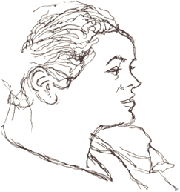A sense of touch
The piano has a mellow tone, the bass strings are set diagonally
to fit a longer string into the space available. I loved the sound
of it and, when I was 7 or 8, I started taking lessons with
Mrs Woodcock, the music teacher at the local secondary
modern school. Even in those days my hands were shakey and, a bag
of nerves at my first exam (in a church hall in Castleford?), I
barely passed. The examiner wrote on my certificate:
'The candidate has a poor sense of touch and a sense of touch
is the basis of good piano playing'
That, thankfully (for my family, if not for me), was the end of
my musical career :-( 
Link
Piano information
(683 pages of it! How did we manage before the internet?) at pianos.co.uk
Richard Bell, richard@willowisland.co.uk | 
Not sure what happened with this drawing of my niece Sarah. She was
talking and moving, so that's probably why the proportions went so
awry. |